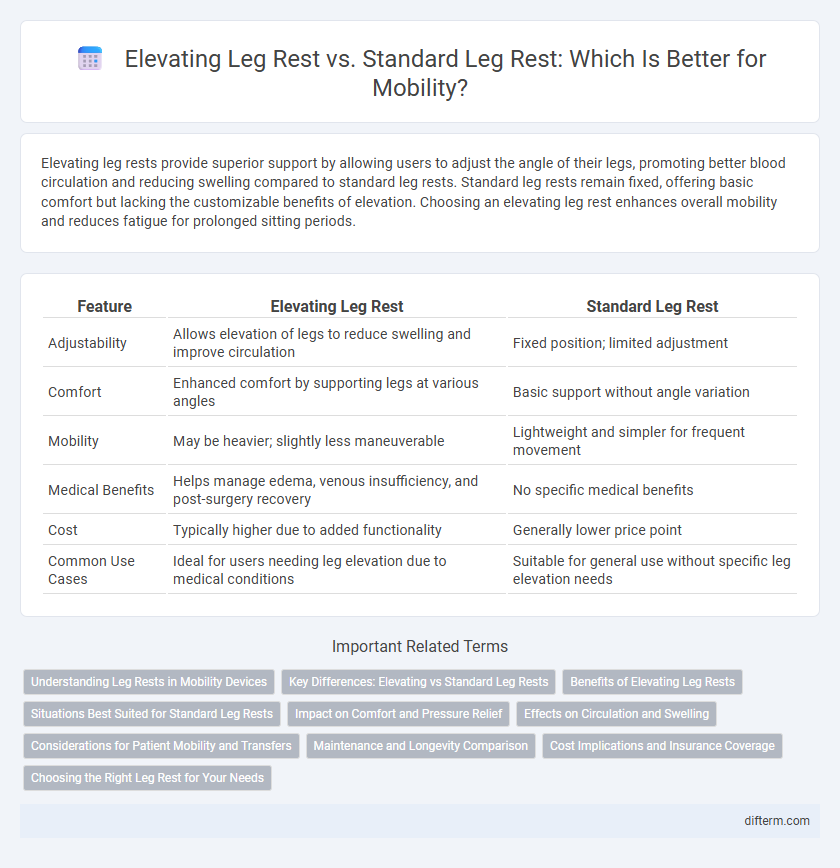Elevating leg rests provide superior support by allowing users to adjust the angle of their legs, promoting better blood circulation and reducing swelling compared to standard leg rests. Standard leg rests remain fixed, offering basic comfort but lacking the customizable benefits of elevation. Choosing an elevating leg rest enhances overall mobility and reduces fatigue for prolonged sitting periods.
Table of Comparison
| Feature | Elevating Leg Rest | Standard Leg Rest |
|---|---|---|
| Adjustability | Allows elevation of legs to reduce swelling and improve circulation | Fixed position; limited adjustment |
| Comfort | Enhanced comfort by supporting legs at various angles | Basic support without angle variation |
| Mobility | May be heavier; slightly less maneuverable | Lightweight and simpler for frequent movement |
| Medical Benefits | Helps manage edema, venous insufficiency, and post-surgery recovery | No specific medical benefits |
| Cost | Typically higher due to added functionality | Generally lower price point |
| Common Use Cases | Ideal for users needing leg elevation due to medical conditions | Suitable for general use without specific leg elevation needs |
Understanding Leg Rests in Mobility Devices
Elevating leg rests in mobility devices provide adjustable support, allowing users to raise their legs to reduce swelling and improve circulation, which standard leg rests typically lack. These advanced leg rests enhance comfort for individuals with specific medical conditions, such as edema or post-surgery recovery, by offering customizable positioning. Standard leg rests provide basic support but do not offer the therapeutic benefits and flexibility associated with elevating models in wheelchairs and power chairs.
Key Differences: Elevating vs Standard Leg Rests
Elevating leg rests offer adjustable height and angle, promoting improved blood circulation and reducing swelling by allowing legs to be elevated above heart level, unlike standard leg rests which remain static and provide basic support. The ergonomic design of elevating leg rests enhances comfort for extended use, making them ideal for individuals with circulation issues or post-surgery recovery needs. Standard leg rests are typically more lightweight and simpler but lack the therapeutic benefits and customizable positioning of elevating leg rests.
Benefits of Elevating Leg Rests
Elevating leg rests improve blood circulation and reduce swelling by allowing users to keep their legs in an elevated position, which standard leg rests do not support effectively. They provide enhanced comfort and pressure relief, particularly for individuals with edema, deep vein thrombosis, or post-surgical recovery needs. This feature also promotes better posture and reduces fatigue during extended periods of sitting, making it essential for mobility devices like wheelchairs and recliners.
Situations Best Suited for Standard Leg Rests
Standard leg rests are best suited for users who require basic leg support during short-term sitting or minimal mobility activities, offering straightforward comfort without complex adjustments. They accommodate environments where simplicity and ease of use are prioritized, such as in daily home use or occasional transportation seating. Their fixed or manually adjustable design makes them ideal for users needing stable support without the need for elevated positioning or pressure relief.
Impact on Comfort and Pressure Relief
Elevating leg rests enhance comfort by allowing users to adjust leg position, reducing pressure on the lower limbs and promoting better circulation. Compared to standard leg rests, they provide superior pressure relief by distributing weight more evenly and preventing swelling or discomfort during prolonged sitting. This ergonomic advantage is crucial for individuals with mobility challenges or circulatory issues, improving overall seating experience and health outcomes.
Effects on Circulation and Swelling
Elevating leg rests improve blood circulation by promoting venous return and reducing the risk of blood pooling, which significantly decreases leg swelling compared to standard leg rests. Enhanced circulation from elevated positioning helps prevent conditions like deep vein thrombosis and reduces discomfort in mobility aids such as wheelchairs. Standard leg rests offer basic support but often fail to mitigate swelling effectively, leading to prolonged tissue congestion and increased fatigue.
Considerations for Patient Mobility and Transfers
Elevating leg rests provide adjustable support that can reduce pressure on the lower limbs, enhancing comfort and promoting better circulation during transfers. Standard leg rests offer a fixed position that may limit customization but are typically simpler to use and maintain stability during patient mobility. Selecting the appropriate leg rest depends on individual mobility needs, transfer frequency, and the patient's ability to manage leg positioning independently.
Maintenance and Longevity Comparison
Elevating leg rests typically feature more complex mechanical components than standard leg rests, requiring regular inspection and occasional lubrication to maintain smooth operation and prevent wear. Due to their adjustable nature, elevating leg rests may experience more stress on joints and hinges, potentially reducing longevity if not properly maintained. Standard leg rests, with simpler fixed designs, generally demand less maintenance and offer greater durability over extended use, making them a reliable choice for users prioritizing minimal upkeep.
Cost Implications and Insurance Coverage
Elevating leg rests typically incur higher upfront costs compared to standard leg rests due to advanced design and increased manufacturing complexity. Insurance coverage for elevating leg rests varies widely, often requiring medical justification such as chronic edema or circulation issues to qualify for reimbursement. Standard leg rests are more commonly covered under basic mobility equipment policies, presenting a more cost-effective option for individuals without specific medical needs.
Choosing the Right Leg Rest for Your Needs
Elevating leg rests provide adjustable support that helps improve circulation and reduce swelling, making them ideal for users with conditions such as edema or post-surgery recovery. Standard leg rests offer fixed positioning and are typically more affordable and simpler to use, suitable for individuals with minimal leg support requirements. Selecting the right leg rest depends on balancing comfort needs, medical conditions, and mobility goals to ensure optimal daily functionality and well-being.
Elevating leg rest vs Standard leg rest Infographic

 difterm.com
difterm.com